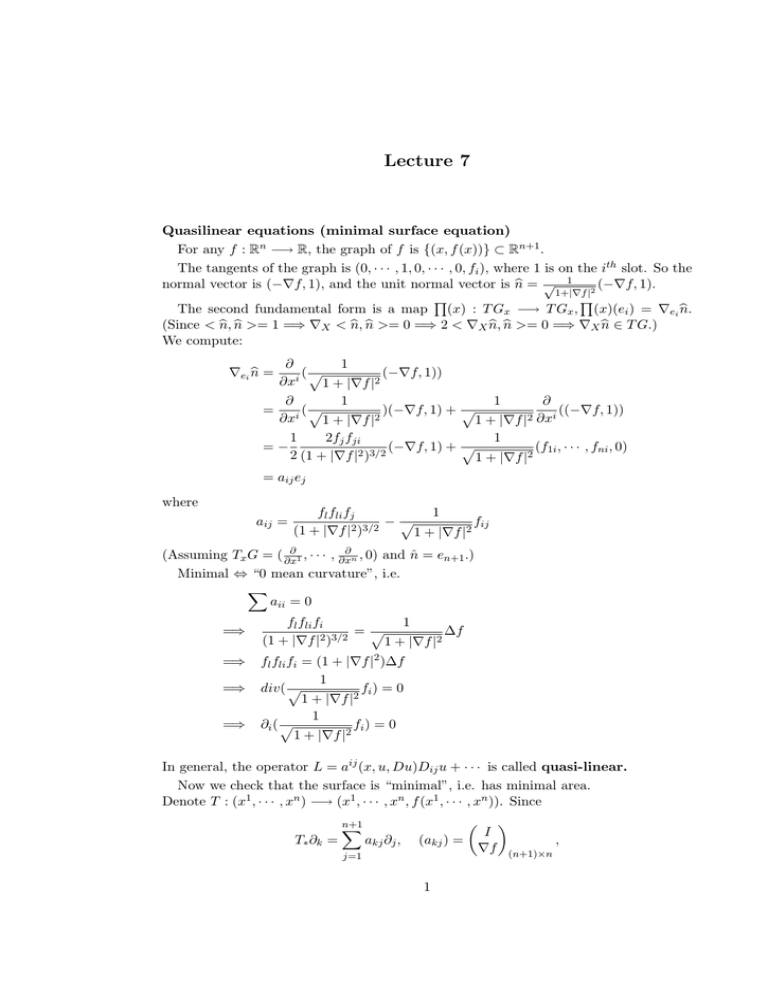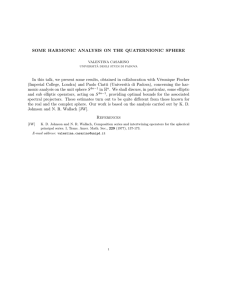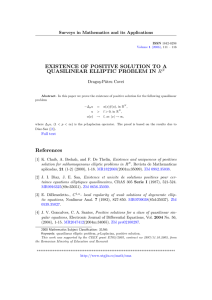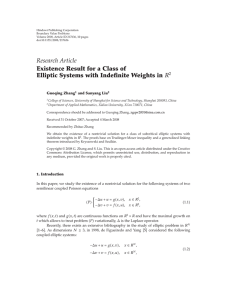Lecture 7
advertisement

Lecture 7
Quasilinear equations (minimal surface equation)
For any f : Rn −→ R, the graph of f is {(x, f (x))} ⊂ Rn+1 .
The tangents of the graph is (0, · · · , 1, 0, · · · , 0, fi ), where 1 is on the ith slot. So the
normal vector is (−�f, 1), and the unit normal vector is n
� = √ 1 2 (−�f, 1).
1+|�f |
�
�
�
The second fundamental form is a map (x) : T Gx −→ T Gx , (x)(ei ) = �ei n.
(Since < n,
� n
� >= 1 =⇒ �X < n,
� n
� >= 0 =⇒ 2 < �X n,
� n
� >= 0 =⇒ �X n
� ∈ T G.)
We compute:
�ei n
�=
∂
1
(−�f, 1))
(�
i
∂x
1 + |�f |2
∂
1
1
∂
(�
)(−�f, 1) + �
((−�f, 1))
i
∂x
1 + |�f |2
1 + |�f |2 ∂xi
2fj fji
1
1
(−�f, 1) + �
(f1i , · · · , fni , 0)
=−
3/2
2
2 (1 + |�f | )
1 + |�f |2
=
= aij ej
where
aij =
fl fli fj
1
fij
−�
3/2
2
(1 + |�f | )
1 + |�f |2
ˆ = en+1 .)
(Assuming Tx G = ( ∂x∂ 1 , · · · , ∂x∂n , 0) and n
Minimal ⇔ “0 mean curvature”, i.e.
�
aii = 0
=⇒
1
fl fli fi
=�
Δf
3/2
2
(1 + |�f | )
1 + |�f |2
=⇒ fl fli fi = (1 + |�f |2 )Δf
1
=⇒ div( �
fi ) = 0
1 + |�f |2
1
=⇒ ∂i ( �
fi ) = 0
1 + |�f |2
In general, the operator L = aij (x, u, Du)Dij u + · · · is called quasi­linear.
Now we check that the surface is “minimal”, i.e. has minimal area.
Denote T : (x1, · · · , xn ) −→ (x1 , · · · , xn , f (x1 , · · · , xn )). Since
T∗ ∂k =
n+1
�
akj ∂j ,
�
(akj ) =
j=1
1
I
�f
�
,
(n+1)×n
we get
T ∗ gRn+1 (∂k , ∂l ) = gRn+1 (T∗ ∂k , T∗ ∂l ) = (AT A)kl = (I + �f �f T )kl = δkl + fk fl .
The matrix I + �f �f T can be diagonized to diag{1 + |�f |2 , 1, · · · , 1}, so the area of
graph of f is
� �
� �
�
T
det(I + �f �f )dx =
(1 + |�f |2 )1/2 dx.
A(f ) =
det(gij )dx =
Rn
Rn
Rn
Thus
d
A(f + th)|t=0
�dt
1
(1 + |�f |2 )−1/2 · 2 < �f, �h > dx
=
2
n
�R
�f
=
<�
, �h > dx
n
1 + |�f |2
R
�
�f
)dx.
=−
h · div( �
1 + |�f |2
Rn
A� (f )h =
Thus Minimal ⇐⇒ div( √
�f
)
1+|�f |2
= 0.
Fully nonlinear equations (Monge­Ampère equation).
Suppose Ω ⊂ Rn . Now we consider the differential equations like
F [u] = F (x, u, Du, D2 u) = 0,
where F : Ω × R × Rn × S(n) −→ R, and S(n) is the set of all symmetric n × n matrices.
∂F
Definition 1 F is elliptic in some subset Γ ⊂ Ω × R × Rn × S(n) if ( ∂r
)(γ) > 0,
ij
∀γ = (x, z, p, r) ∈ Γ.
∂F
) > λI for all γ ∈ Γ, then we say F uniformly
If ∃Λ, λ > 0 such that ΛI > ( ∂r
ij
elliptic.
If u ∈ C 2 (Ω), and F is elliptic on range of x → (x, u, Du, D2 u), then we say F is
elliptic with respect to u.
Example: Monge­Ampère Equation
F [u] = detD2 u − f (x) = 0.
(Note that Δu = trace(D2 u)).
2
We do some computation:
�
det rij =
(−1)signσ r1σ(1) r2σ(2) · · · rnσ(n) ,
σ∈Sn
∂F
∂rij = (i, j)−cofactor
(r−1 )ij = det1 r Fij (r),
Fij (r) = det r · (r−1 )ij .
Fij (r) =
of r,
So F is elliptic when r is positive definite, and thus F [u] is elliptic if u is strictly
convex.
More generally, F [u] = det D2 u − f (x, u, Du) = 0 is elliptic for strictly convex
functions.
Given F [u], define the linearization of F at a function u to be
F � [u] : C 2 (Ω) → R,
h �−→
d
F [u + th]|t=0 .
dt
d
F [x, u + th, Du + tDh, D2 u + tD2 h]|t=0
dt
= Fz (u)h + Fpi hi + Frij (u)Dij h
F � [u](h) =
= (Frij (u)Dij + FPi (u)Di + Fz (u))h
= Lh
So our definition of elliptic at u ⇔ linearization of F at u is an elliptic operator.
Example: Linearization of Monge­Ampère:
F [u] = detD2 u − f (x).
F � [u](h) = Frij (D2 u)Dij h
Let λi be eigenvalues of D2 u, then eigenvalues of Frij are
λ2 · · · λn , λ1 λ3 · · · λn , · · · , λ1 · · · λn−1
Certainly F is not uniformly elliptic.
Elementary Symmetric Function: σk (D2 u) = Sum of principal k × k matrix.
�
σk (λ1 , · · · , λn ) =
λi1 · · · λik ,
i1 <···<ik
Now for F [u] = detD2 u − f (x), F � [u](h) = Frij (D2 u)Dij h, when is it elliptic?
Theorem 1 If σk > 0, σk−1 > 0, · · · , σ1 > 0, then Frij > 0.
3
Γk = {componentof σk > 0}.
Example: n = 3.
det = λ1 λ2 λ3 ,
σ2 = λ1 λ2 + λ1 λ3 + λ2 λ3 ,
Δ = λ1 + λ2 + λ3 .
Γ3 = {positive cone}.
For Γ2 , σ2 = 0 is a cone, so {σ2 > 0} has two components, Γ+
2 =
{x2 > 0}∩{σ1 > 0},
e.v. of Frij on (λ2 + λ3 , λ1 + λ3 , λ1 + λ2 ),
λ1 λ2 + λ1 λ3 + λ2 λ3 > 0,
λ1 + λ2 + λ3 > 0.
Claim: If λ1 ≥ λ2 ≥ λ3 , then λ2 > 0.
In fact, by λ1 λ2 + λ1 λ3 + λ2 λ3 > 0, we get
λ1 (λ2 + λ3 ) + λ2 λ3 > 0,
i.e.
λ1 (λ2 + λ3 ) > −λ2 λ3 .
If λ2 ≤ 0,then λ2 + λ3 < 0, thus we get
−λ2 λ3
λ2 + λ3
−λ2 λ3
=⇒ − λ2 − λ3 <
λ2 + λ3
λ2 λ3
=⇒λ2 + λ3 >
λ 2 + λ3
=⇒(λ2 + λ3 )2 < λ2 λ3
− λ2 − λ3 < λ1 ≤
=⇒λ22 + λ2 λ3 + λ23 < 0
which is a contradiction.
So we have λ1 , λ2 > 0, thus λ1 + λ2 > 0.
If λ1 + λ3 ≤ 0, then λ1 λ3 < 0, which contradicts with λ2 (λ1 + λ3 ) + λ1 λ3 > 0. Thus
λ1 + λ3 > 0.
Also from λ1 (λ2 + λ3 ) + λ2 λ3 > 0, we can get λ2 + λ3 > 0 by the same way.
Theorem 2 σ2 (D2 u) = f (x) is elliptic if f (x) > 0 and Δu ≥ 0.
σk (D2 u) = f (x) is elliptic if f (x) > 0, D2 u ∈ Γ+
k , and σk > 0, σk−1 > 0, · · · , σ1 > 0.
Comparison principle for nonlinear equations.
First we give a maximum principle.
4
Theorem 3 Let u, v ∈ C 0 (Ω) ∩ C 2 (Ω) satisfy F [u] ≥ F [v] in Ω, u ≤ v on ∂Ω, and
(i) F is elliptic along the straight line path tu + (1 − t)v,
(ii) Fz ≤ 0.
Then u ≤ v in Ω.
Proof:
�
1
d
F [tu + (1 − t)v]dt
dt
0
� 1
d
=
Frij (tD2 u + (1 − t)D2 v) + Fpi (Di u − Di v) + Fz (u − v)dt
dt
0
� 1
� 1
� 1
2
Fz dt)(u − v)
Fpi dt)Di (u − v) + (
=(
Frij dt)Dij (u − v) + (
F [u] − F [v] =
0
0
0
= L(u − v)
> 0,
but u ≤ v on ∂Ω. Since elliptic on path, we get aij > 0 and c ≤ 0, thus u ≤ v in Ω. �
Corollary 1 Suppose u, v ∈ C 0 (Ω) ∩ C 2 (Ω) satisfy F [u] = F [v] in Ω, and (i),(ii) hold,
with u = v on ∂Ω. Then u = v in Ω.
Example: Monge­Ampère.
detD2 u = f (x) > 0, detD2 v = f (x), with u, v strictly convex, tu + (1 − t)v is also
strictly convex. So (i) works. For (ii), there is no z dependence. So u = v on ∂Ω
implies u = v on Ω.
Similarly for σk .
Result also works for Minimal surface.
Theorem 4 Suppose u ∈ C 2 (Ω), F [u] = 0, and F elliptic with respect to u. Also
suppose F is C ∞ , (e.g. detD2 u = f (x) > 0 ∈ C ∞ ). Then u ∈ C ∞ (Ω).
Proof:Use difference quotients. Fix coordinate vector e1 .
Let v(x) = u(x + he1 ), h ∈ R, and ut = tv + (1 − t)u, 0 ≤ t ≤ 1.
� 1
d
F (x + the1 , ut , Dut , Dtu ))dt = F (x + he1 , v, Dv, D2 v) − F (x, u, Du, D2 u) = 0,
0 dt
� 1
� 1
� 1
� 1
Fx1 (·)h +
Fz (·)(v − u) +
Fpi (·)Di (v − u) +
Frij (·)Dij (v − u) = 0.
0
0
0
0
We can write this to be
L(v − u) = −f · h.
Thus
v−u
L(
) = L(Δh � u) = −f =
h
1
�
Fx1 (x + the1 , ut , Dut , D2 ut )dt.
0
5
So
Δh � u ∈ W 2,p , ∀p =⇒ u ∈ W 3,p .
(We will prove this later.)
By Sobolev embedding, u ∈ C 2,α .
Then f ∈ C α =⇒ Δh u ∈ C 2,α =⇒ u ∈ C 3,α
=⇒ f ∈ C 1,α =⇒ Δh u ∈ C 3,α =⇒ u ∈ C 4,α .
Go on with this procedure, we get C ∞ at last.
6
�





